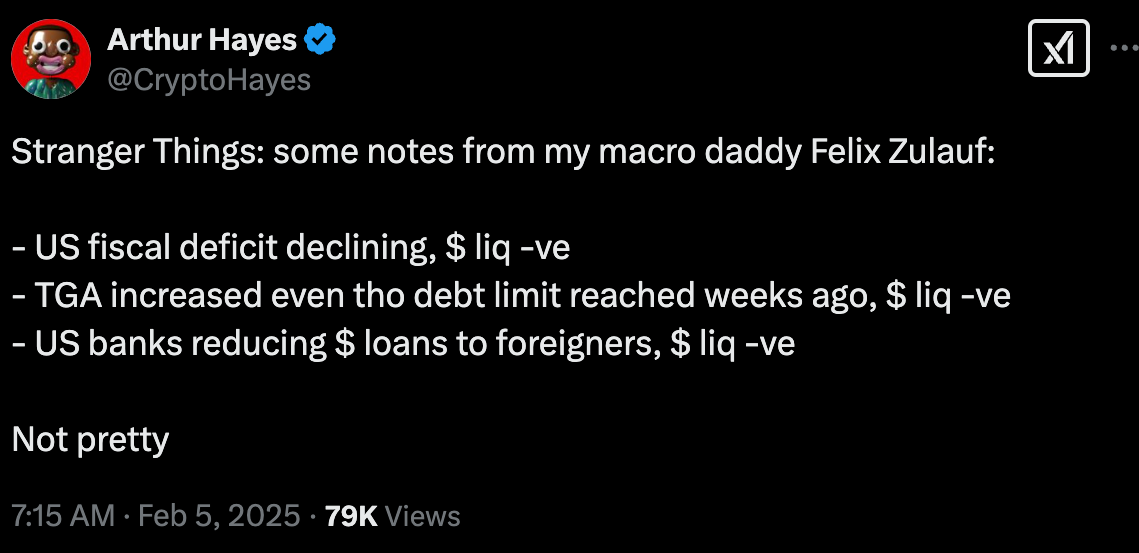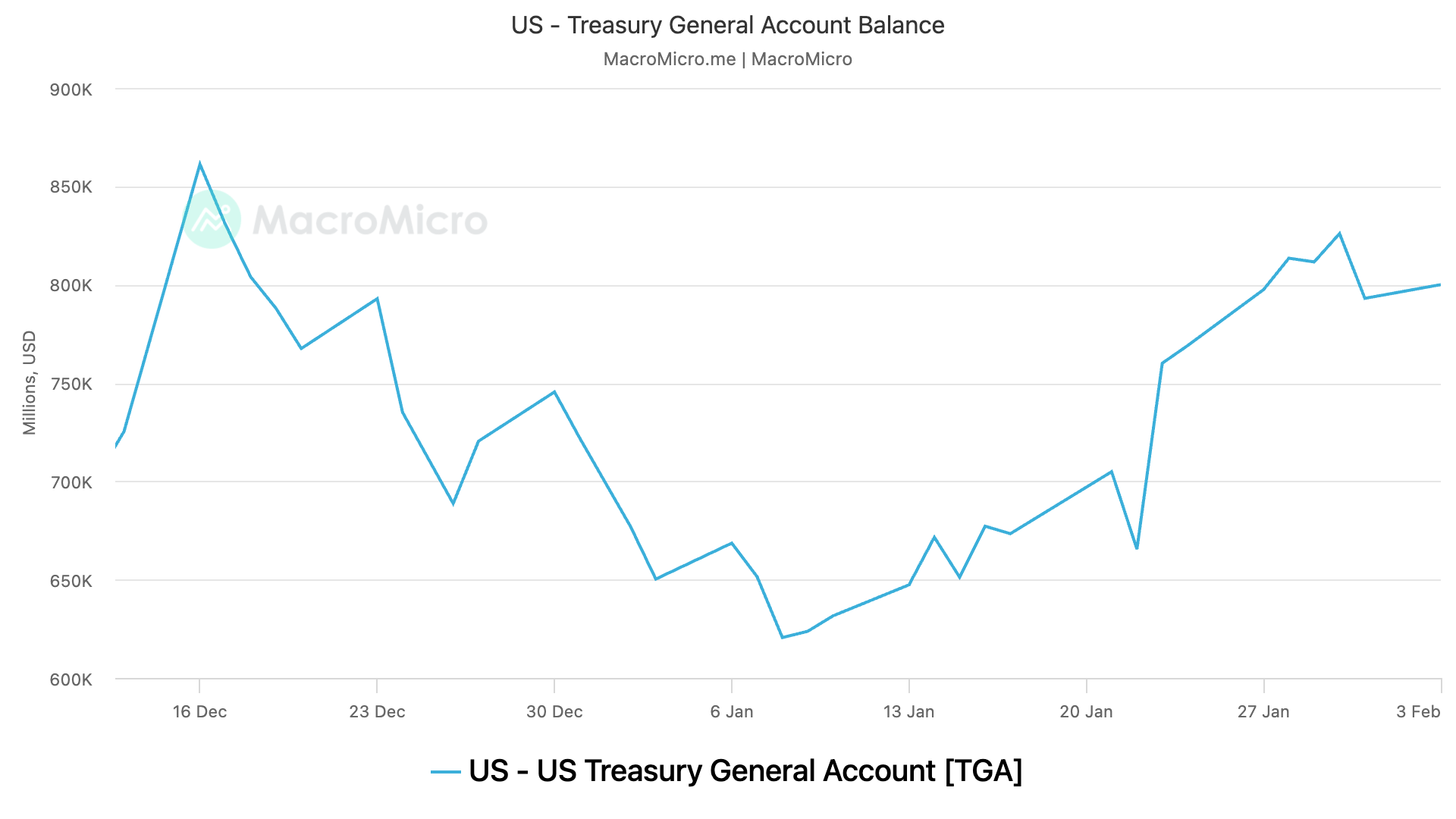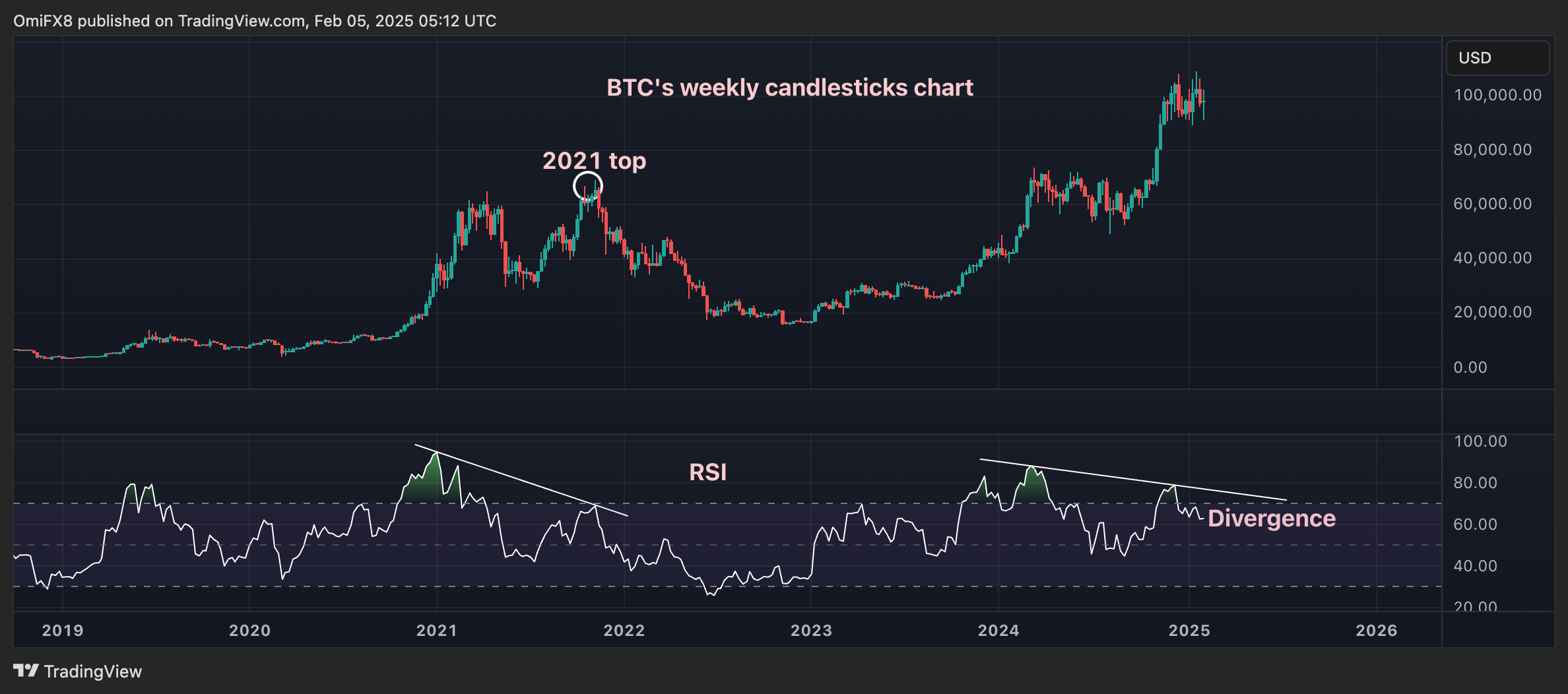Uncategorized
Bitcoin Risks Losing the $90K- $110K Range as These 3 Development Could Put the Brakes on the Next Bull Breakout

Since early 2023, Bitcoin (BTC) has chalked out a classic stairstep bull run, characterized by incremental price increases followed by periods of consolidation that set the stage for the next move higher.
The cryptocurrency’s ongoing price consolidation between $90,000 and $100,000 is the third of the broader bull run from $20,000. The consensus is that it will end in a bull breakout, just as those in mid-2024 and 2023 did.
However, the following three developments, suggest otherwise.
Tightening USD liquidity
If there’s one thing that any asset class, not just crypto, typically dislikes, it’s the tightening of fiat liquidity, particularly the global reserve currency, the U.S. Dollar (USD). To the dismay of BTC bulls, the dollar liquidity is tightening due to several factors, as Arthur Hayes, chief investment officer at Maelstrom, noted on X.

Notably, the USD cash balance held in the Treasury General Account (TGA), the U.S. government’s checking account at the Fed, has increased from $623 billion to $800 billion in four weeks, according to data source MacroMicro.
After the U.S. hit its self-imposed debt limit of $36 trillion last month, markets hoped that the Treasury would run down the TGA balance as part of extraordinary measures to keep the government functioning, inadvertently enhancing liquidity in the economy and markets. That’s what the Treasury did during the previous debt ceiling issue of early 2023, spurring increased risk-taking in equity and crypto markets.
«We’re looking at a scenario where key liquidity sources are drying up or being more tightly controlled. This could lead to a slowdown in economic activity, higher borrowing costs, and potentially a more challenging environment for risk assets, including crypto,» Anddy Lian, thought leader and intergovernmental blockchain expert, said on X.

Trump administration to ‘evaluate’ strategic BTC reserve
Since President Donald Trump took office on Jan. 20, he has been actively following through on various campaign promises related to tariffs, illegal migrants and international affairs.
But, there is one notable exception: the establishment of a strategic BTC reserve. It was a significant catalyst behind BTC’s surge from $70,000 to over $100,000.
The Trump administration seems to be more cautious, opting to «evaluate» the feasibility of creating such a reserve. It’s a disappointing shift for crypto investors anticipating swift action on this initiative, similar to Trump’s quick responses on other issues.
«Wait, Trump said he would do a $BTC Reserve, not promise to ‘evaluate it.’ Evaluate/Study is what Washington does when they don’t want to do something,» Jim Bianco, president and macro strategist at Bianco Research, LLC, said.
BTC fell from over $100,000 to $96,000 during the overnight trade after Trump’s crypto Czar told CNBC that a top agenda item for his new task force is evaluating the feasibility of a bitcoin reserve.
Reappearance of a 2021 topping pattern
Finally, those looking at technical charts to gauge the next move might want to pull up the 14-week relative strength index (RSI) on their screens.
That’s because the oscillator has recently diverged bearishly in a move that marked the 2021 top. A bearish RSI divergence contradicts the higher high in prices, signaling a slowdown in the bullish momentum.

The RSI has produced a lower high relative to its December high, diverging bearishly from the continued price uptrend. That’s similar to the 2021 pattern.
The negative setup would be invalidated should the RSI cross above the falling trendline, representing the divergence, indicating a renewed bullish momentum.
Uncategorized
Memecoins Under Pressure as SHIB, Dogecoin Slide After Shibarium Loses $2.4M in Hack

Top meme tokens traded under pressure as a multimillion dollar hack of Shiba Inu’s layer-2 network, Shibarium, dented investor confidence in joke cryptocurrencies.
On Sunday, Shibarium fell victim to a flash loan attack on its validator system, which drained about $2.4 million in ether (ETH) and SHIB. The CoinDesk Memecoin Index has dropped 6.6% in the past 24 hours. The broader market CoinDesk 20 Index (CD20) is down just 2.3%.
The attacker borrowed 4.6 million BONE, the governance token for the Shiba Inu ecosystem, often linked to the decentralized exchange (DEX) ShibaSwap, through a flash loan to gain control of the majority of validator keys. The keys act as gatekeepers of the network, confirming transactions and ensuring security.
With that control, the attacker was able to game the system into approving unauthorized transactions and walk away with a large amount of crypto assets from the bridge that connects Shibarium with the Ethereum blockchain. The process is akin to someone temporarily taking over a bank’s security system to approve unauthorized withdrawals. A flash loan is a loan raised with no upfront collateral and returns the borrowed assets within the same blockchain transaction.
The Shiba inu team was able to prevent a bigger, more serious breach because the BONE tokens used to gain control were reportedly tied to validator 1 and remained locked by the staking rules.
Nevertheless, markets reacted negatively breach, which again underscores the perennial security issues with blockchain technology.
Memecoins drop, broader market bid
SHIB fell by the most in three weeks on Sunday (UTC), losing 4% $0.00001369, and has continued to weaken to trade recently at $0.00001359. The cryptocurrency experienced considerable volatility throughout the 23-hour trading window ended Sept. 15 at 02:00 UTC, with the aggregate range encompassing $0.000006191, a 4% oscillation from peak to trough.
The session commenced with pre-dawn fragility as SHIB retreated from $0.000014156 to establish a pivotal trough of $0.000013547 at 14:00 UTC. Volume of 1.064 trillion tokens surpassed the 24-hour mean, signaling robust distribution pressure and prospective capitulation, according to CoinDesk Research’s technical analysis model.
The BONE token, which initially doubled to over 36 cents, is now down over 2% on a 24-hour basis, trading at around 20 cents.
According to the technical analysis model:
- SHIB established a critical underpinning at $0.000013547 during elevated volume selling pressure exceeding 1.064 trillion tokens.
- The token constructed successive higher lows and consolidation parameters between $0.000013600-$0.000013780.
- Recovery momentum is demonstrated by ascending channel formations with sustained higher lows, indicating potential continuation towards the $0.000014000 resistance.
- Volume patterns exceeded 24-hour averages during the decline phase, confirming potential capitulation levels.
- Terminal hour trading exhibited decisive upward momentum with 1% appreciation, confirming a breach above the resistance threshold.
Large DOGE transfers add to bearish sentiment
Meanwhile, SHIB’s peer dogecoin (DOGE) fell 4% to 27.80 cents on Sunday and has since lost further 5% to 27.36 cents, according CoinDesk data.
A massive transfer of DOGE to a centralized exchange likely added to the bearish mood in the market. According to Whale Alert, crypto exchange OKX received 119,306,143 DOGE, worth over $34 million, from an unknown wallet. Such large transfers are typically associated with an intention to liquidate holdings.
Uncategorized
Fed Rate Decision, MKR-SKY Conversion Deadline: Crypto Week Ahead

The U.S. Federal Reserve is likely to dominate markets, both crypto and traditional, in the coming week. Traders are positioned for a rate cut of at least 25 basis points when the Fed announces its decision on Sept. 17, according to CME’s Fedwatch tool.
What to Watch
- Crypto
- Sept. 16, 12 p.m. ET: Solana AMA on X.
- Sept. 18: Mavryk Network launches its mainnet and native MVRK token.
- Sept. 18: Rex-Osprey Dogecoin ETF expected to begin trading on Cboe BZX Exchange under ticker DOJE.
- Sept. 18: Unipoly Chain (UNP) mainnet launch.
- Macro
- Sept. 16: Brazil July unemployment rate Est. N/A (Prev. 5.8%).
- Sept. 16: Canada August headline CPI YoY Est. N/A (Prev. 1.7%), MoM Est. N/A (Prev. 0.3%); core YoY Est. N/A (Prev. 2.6%), MoM Est. N/A (Prev. 0.1%).
- Sept. 16: U.K. July unemployment rate Est. 4.7%.
- Sept. 17: U.K. August headline CPI YoY Est. 3.9%. MoM Est. N/A (Prev. 0.1%); core YoY Est. 3.7%, MoM Est. N/A (Prev. 0.2%).
- Sept. 17: Canada benchmark interest rate Est. N/A (Prev. 2.75%) followed by a press conference.
- Sept. 17: The Fed’s FOMC decision on U.S. interest rates. Est: 25 bps cut to 4.00%-4.25% followed by a press conference.
- Sept. 17: Brazil benchmark interest rate Est. N/A (Prev. 15%).
- Sept. 18: Bank of England decision on U.K. interest rates. Est: unchanged at 4%.
- Sept. 19: Bank of Japan interest-rate decision. Est: unchanged at 0.5%.
- Earnings (Estimates based on FactSet data)
- Sept. 18: Lite Strategy (MEIP), pre-market
Token Events
- Governance votes & calls
- Curve DAO is voting to changes to donation-enabled Twocrypto contracts. Voting ends Sept. 16.
- Sept. 16: Aster Network to host a community call.
- MantleDAO is voting on keeping the 2025-2026 budget at $52 million USDc and 200 million MNT. Voting ends Sept. 18
- Sept. 18, 6 a.m.: Mantle to host Mantle State of Mind, a monthly townhall series.
- Sept. 16, 12 p.m.:Kava to host a community Ask Me Anything (AMA) session.
- Sept. 23: SwissBorg to make a live announcement.
- Unlocks
- Sept. 15: Starknet (STRK) to unlock 5.98% of its circulating supply worth $17.09 million.
- Sept. 15: Sei (SEI) to unlock 1.18% of its circulating supply worth $18.06 million.
- Sept. 16: Arbitrum (ARB) to unlock 2.03% of its circulating supply worth $48.16 million.
- Sept. 17: ZKsync (ZK) to unlock 3.61% of its circulating supply worth $10.54 million.
- Sept. 18: Fasttoken (FTN) to unlock 2.08% of its circulating supply worth $89.8 million
- Sept. 20: Velo (VELO) to unlock 13.63% of its circulating supply worth $43.39 million.
- Sept. 20: KAITO (KAITO) to unlock 3.15% of its circulating supply worth $10.1 million.
- Token Launches
- Sept. 15: OpenLedger (OPENLEDGER) to be listed on Crypto.com.
- Sept. 18: Deadline to convert MKR to SKY before the delayed upgrade penalty takes effect.
- Sept. 20: Reserve Rights (RSR) to conduct a token burn.
- Sept. 22: Falcon Finance to host community sale on Buidlpad.
Conferences
- Sept.12-15: ETHTokyo 2025 (Tokyo, Japan)
- Sept. 15: TGE Summit 2025 (New York)
- Sept. 15-21: Budapest Blockchain Week 2025 (Budapest, Hungary)
- Sept. 16-17: Real-World Asset Summit (New York)
- Sept. 17: The Bitcoin Treasuries NYC Unconference (New York)
- Sept. 17-19: AIBC 2025 (Tokyo, Japan)
- Sept. 18: CBC Summit USA (Washington)
- Sept. 19: DEF-AI 2025 (Tblisi, Georgia)
- Sept. 17-20: Nomad Capitalist Live 2025 (Kuala Lumpur, Malaysia)
- Sept. 21: XRP Seoul 2025 (Seoul, South Korea)
Uncategorized
Bank of England’s Proposed Stablecoin Ownership Limits are Unworkable, Says Crypto Group

The Financial Times (FT) reported on Monday that cryptocurrency groups are urging the Bank of England (BoE) to scrap proposals limiting the amount of stablecoins individuals and businesses can own.
The group warned that the rules would leave the UK with stricter oversight than the U.S. or the European Union (EU).
According to the FT, BoE officials plan to impose caps of 10,000 british pounds to 20,000 british pounds ($13,600–$27,200) for individuals and about 10 million british pounds ($13.6 million) for businesses on all systemic stablecoins, defined as tokens already widely used for payments in the U.K. or expected to be in the future.
The central bank has argued the restrictions are needed to prevent outflows of deposits from banks that could weaken credit provision and financial stability.
The FT cited Sasha Mills, the BoE’s executive director for financial market infrastructure, as saying the limits would mitigate risks from sudden deposit withdrawals and the scaling of new systemic payment systems.
However, industry executives told the FT the plan is unworkable.
Tom Duff Gordon, Coinbase’s vice president of international policy, said “imposing caps on stablecoins is bad for U.K. savers, bad for the City and bad for sterling,” adding that no other major jurisdiction has imposed such limits.
Simon Jennings of the UK cryptoasset business council said enforcement would be nearly impossible without new systems such as digital IDs. Riccardo Tordera-Ricchi of The Payments Association told the FT that limits “make no sense” because there are no caps on cash or bank accounts.
The U.S. enacted the GENIUS Act in July, which establishes a federal framework for payment stablecoins. The law sets licensing, reserve and redemption standards for issuers, with no caps on individual holdings. The European Union has also moved ahead with its Markets in Crypto-Assets Regulation (MiCA), which is now fully in effect across the bloc.
Stablecoin-specific rules for asset-referenced and e-money tokens took effect on June 30, 2024, followed by broader provisions for crypto-assets and service providers on Dec. 30, 2024. Like the U.S. approach, MiCA does not cap holdings, instead focusing on reserves, governance and oversight by national regulators.
-

 Business11 месяцев ago
Business11 месяцев ago3 Ways to make your business presentation more relatable
-

 Fashion11 месяцев ago
Fashion11 месяцев agoAccording to Dior Couture, this taboo fashion accessory is back
-

 Entertainment11 месяцев ago
Entertainment11 месяцев ago10 Artists who retired from music and made a comeback
-

 Entertainment11 месяцев ago
Entertainment11 месяцев ago\’Better Call Saul\’ has been renewed for a fourth season
-

 Entertainment11 месяцев ago
Entertainment11 месяцев agoNew Season 8 Walking Dead trailer flashes forward in time
-

 Business11 месяцев ago
Business11 месяцев ago15 Habits that could be hurting your business relationships
-

 Entertainment11 месяцев ago
Entertainment11 месяцев agoMeet Superman\’s grandfather in new trailer for Krypton
-

 Entertainment11 месяцев ago
Entertainment11 месяцев agoDisney\’s live-action Aladdin finally finds its stars





